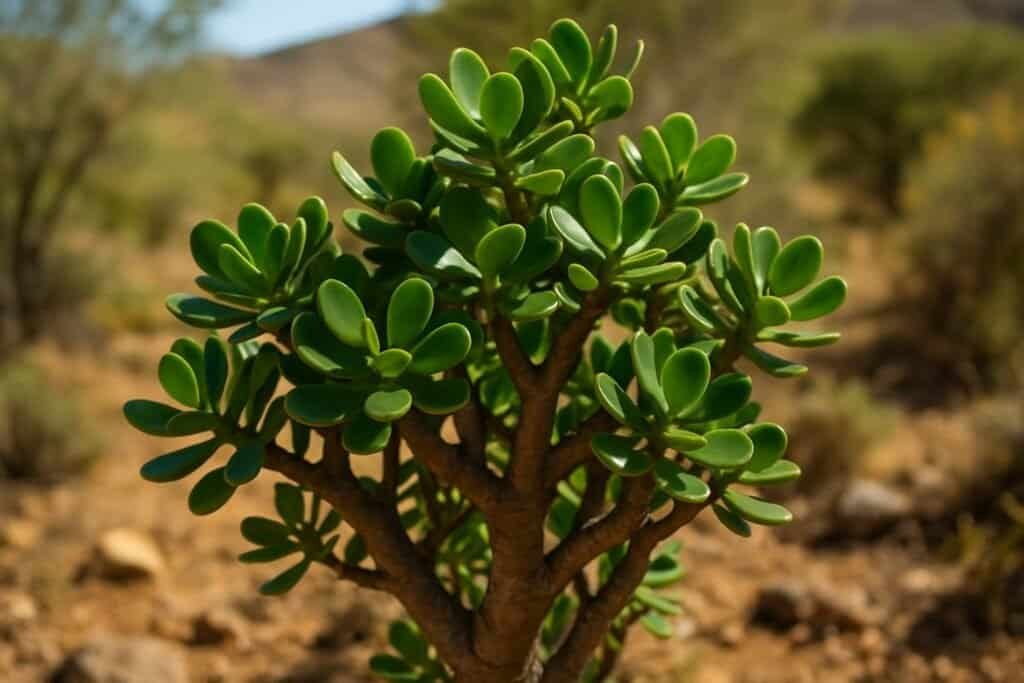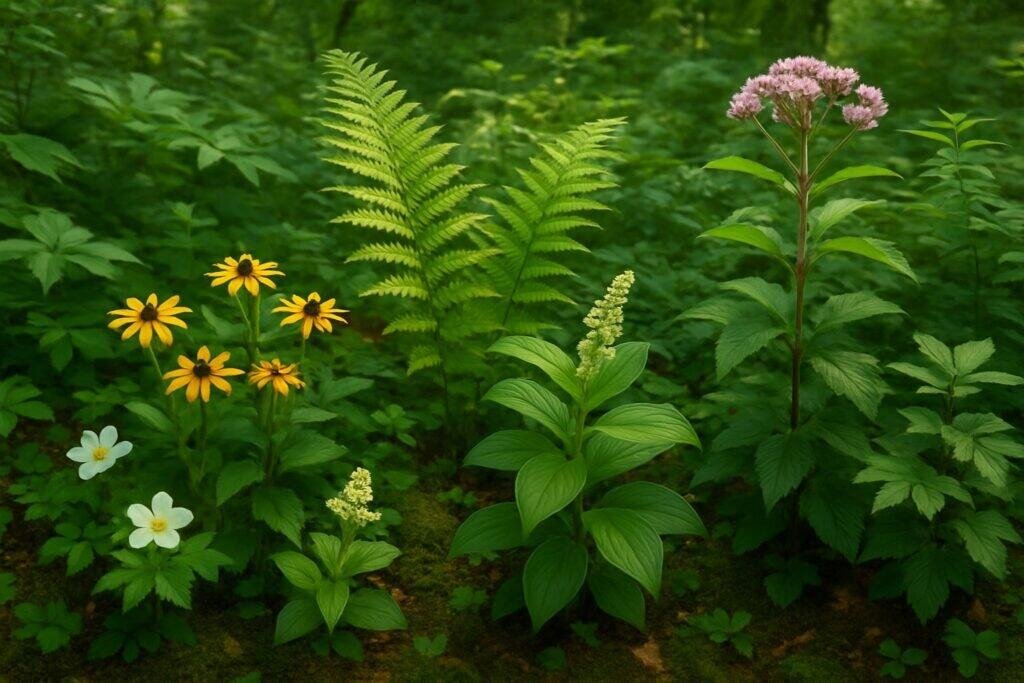Jade plants have become popular houseplants worldwide. Many people don’t know where these beautiful succulents come from.
Jade plants (Crassula ovata) are native to South Africa, specifically the Eastern Cape and KwaZulu-Natal provinces, as well as Mozambique. In these regions, they grow naturally in dry, rocky areas and store water in their thick leaves.
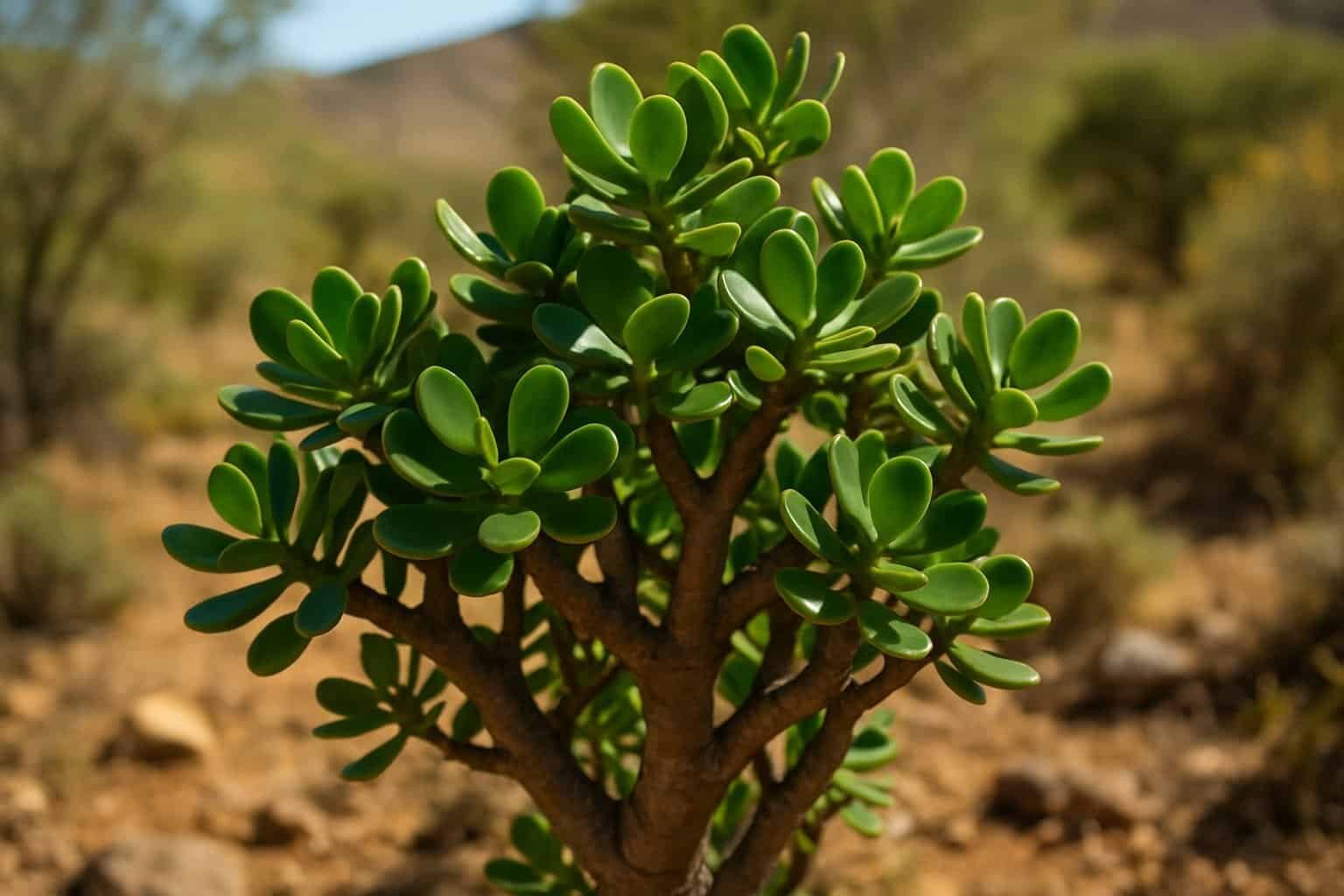
These resilient succulents have spread across the globe as beloved houseplants because of their hardiness and attractive appearance. In their native habitat, jade plants can grow much larger than the potted specimens seen in homes.
Wild jade plants sometimes reach heights of up to 10 feet. Their fleshy leaves and tree-like growth pattern make them instantly recognizable among succulent enthusiasts.
Key Takeaways
- Jade plants (Crassula ovata) originate from South Africa and Mozambique, growing in dry, rocky habitats.
- In the wild, jade plants can grow up to 10 feet tall, much larger than typical houseplants.
- These succulents have spread globally as houseplants due to their drought tolerance and association with prosperity.
Origins of the Jade Plant
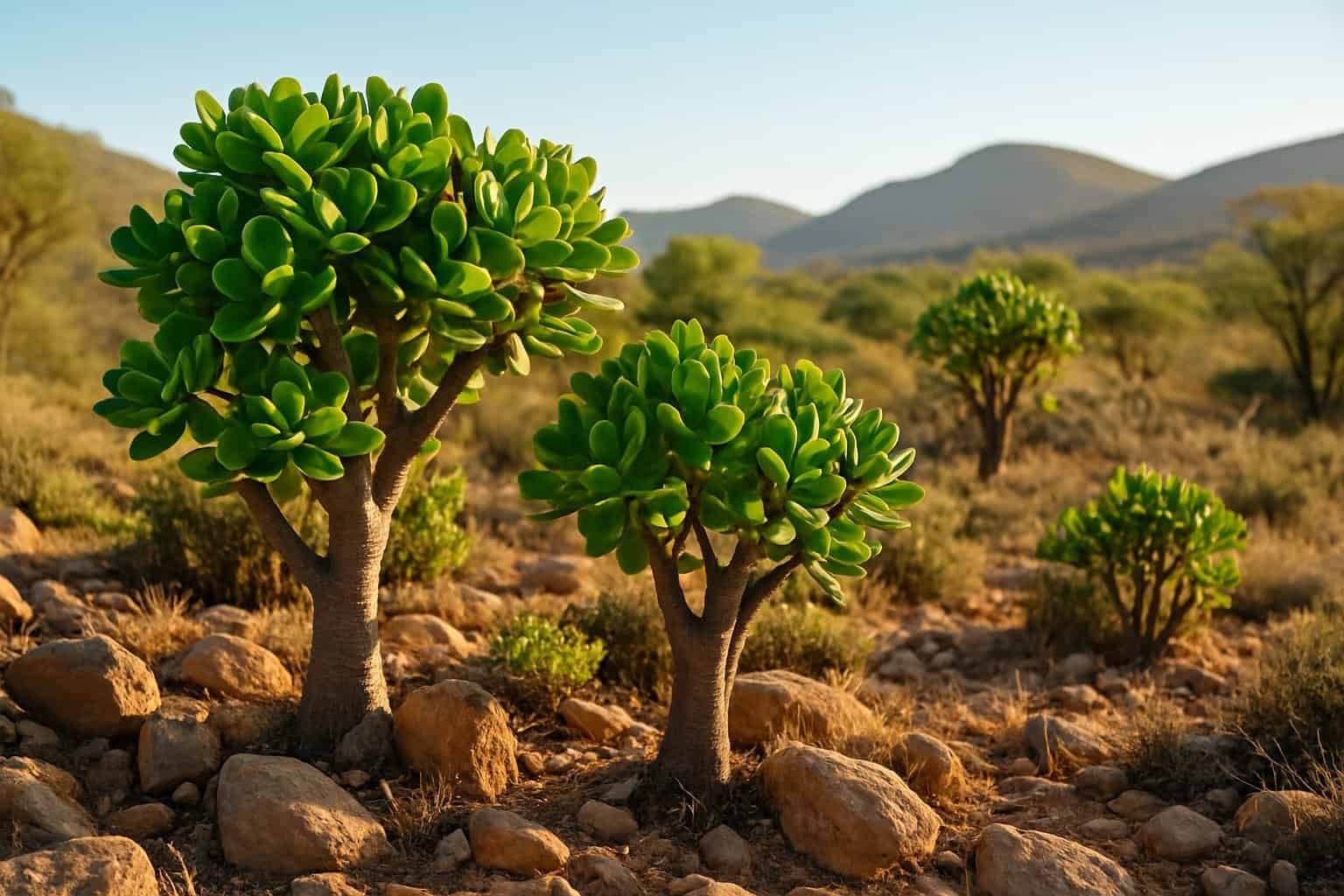
The Jade Plant (Crassula ovata) comes from specific regions in Africa. It evolved to thrive in harsh conditions.
Its natural adaptations help it survive in challenging environments. The plant stores water in its leaves to handle dry spells.
Native Regions of Crassula ovata
Jade plants are native to South Africa and Mozambique, especially in the eastern and southern parts of South Africa. They grow abundantly in the Eastern Cape and KwaZulu-Natal provinces.
In these areas, Crassula ovata grows wild on rocky hillsides and slopes. The plant belongs to the Crassulaceae family, which includes many drought-resistant succulents.
Botanists have found jade plants in both coastal and inland areas. They often grow in crevices between rocks, anchoring their roots and finding protection from extreme elements.
Climate and Natural Environment
Jade plants thrive in arid and semi-arid climates. They experience hot, dry summers and mild, slightly wetter winters in their native habitat.
These succulents receive irregular rainfall in the wild and sometimes go months without water. This has given them impressive drought-tolerance and water storage abilities.
Crassula ovata prefers well-draining soil that doesn’t hold moisture for long. In nature, they grow in sandy or rocky soil with excellent drainage.
Jade plants receive plenty of sunlight in their native environment. They store water in their thick, fleshy leaves—a classic survival strategy of succulents.
Distribution and Global Spread
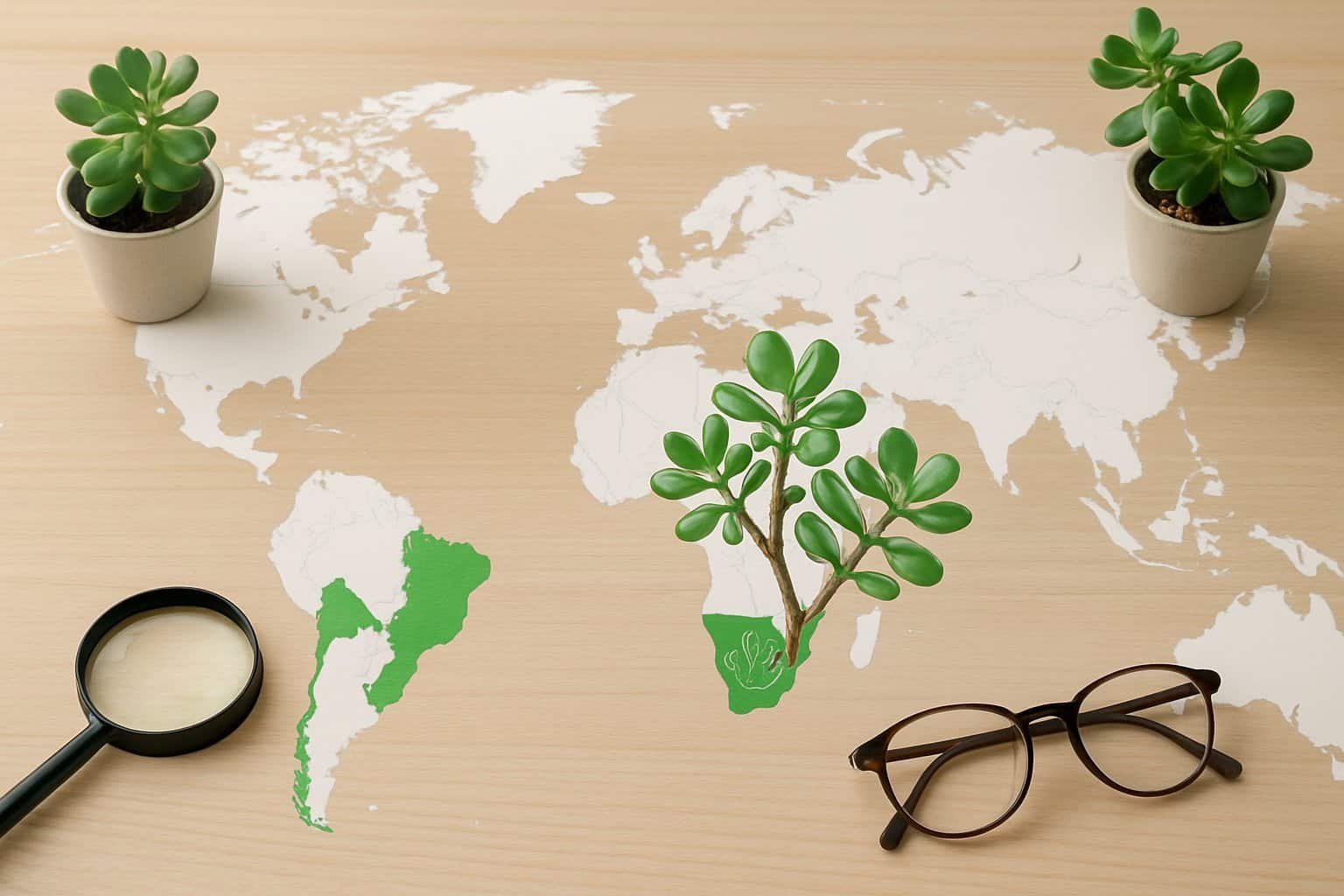
Jade plants originated in South Africa but now grow far beyond their native habitat. Their adaptability has allowed them to thrive in many regions as garden specimens and houseplants.
Jade Plant Expansion Beyond Africa
Plant collectors brought jade plants to Europe during the colonial era. By the early 20th century, they had reached America and other regions.
Their popularity soared in the 1970s as houseplants became trendy. Today, jade plants grow in homes and gardens across Europe, North America, Australia, and parts of Asia.
Commercial nurseries worldwide propagate millions of jade plants each year for the indoor plant market. Many botanical gardens feature jade plants in their succulent displays.
Adaptability to Different Climates
Jade plants adapt to many environments. In Mediterranean climates like southern California, they thrive outdoors year-round in succulent gardens.
Their drought tolerance makes them perfect for water-wise landscapes. In colder areas, jade plants grow well indoors and tolerate the dry air of heated homes during winter.
They can survive with minimal care because they store water in their leaves. Jade plants prefer temperatures between 65-75°F (18-24°C) but can survive brief drops to 50°F (10°C).
This adaptability explains why jade plants flourish in so many settings, from bright windowsills to outdoor gardens in warm regions.
Distinct Features of Jade Plants
Jade plants have several features that make them popular houseplants. Their distinctive appearance and resilience have earned them a place in home gardens and collections.
Physical Characteristics
Jade plants (Crassula ovata) have thick, glossy leaves that store water. These leaves are oval-shaped and usually grow in pairs along the stems.
Leaf color ranges from deep green to bluish-green. Some varieties develop a red tinge on the edges in direct sunlight.
The stems start green and fleshy but become woody and trunk-like with age. This gives older jade plants a miniature tree-like look, similar to bonsai.
Some jade varieties show interesting patterns or variegation on their leaves. Mini jade plants (Crassula ovata ‘Minima’) have smaller leaves but keep the same appearance as larger types.
The plant’s surface often looks smooth and shiny, which adds to its ornamental value.
Growth Habit and Longevity
Jade plants can live for decades when cared for properly. They grow slowly, eventually reaching heights of 3-6 feet in ideal conditions.
Their upright, branching growth creates a tree-like structure over time. These evergreen plants keep their greenery year-round, providing visual interest.
Jade plants thrive in both bright light and semi-shaded conditions. They require little maintenance and infrequent watering.
During spring and early summer, mature jade plants may produce small star-shaped white or pink flowers. Growth slows in winter and speeds up in warmer months.
Their ability to withstand occasional neglect makes them ideal for new plant owners.
Common Varieties and Cultivars
Jade plants come in many shapes, sizes, and colors. Dozens of cultivars are now available to plant enthusiasts worldwide.
Popular Types of Jade Plants
The classic Crassula ovata is the most common jade plant. It has thick oval leaves and a tree-like growth habit.
Hummel’s Sunset stands out with golden-yellow leaf tips that become brighter with more sun. The quirky Gollum (Crassula ovata ‘Gollum’) has tubular leaves with reddish tips that look like small trumpets or fingers.
Hobbit Jade is similar to Gollum but has more curved, spoon-like leaf tips. Skinny Fingers has extremely narrow, elongated leaves.
Variegated Jade displays cream or white stripes on its leaves. Silver Dollar Jade is smaller than standard varieties and has rounded, silver-blue leaves.
Dwarf Jade varieties stay compact, making them perfect for small spaces and containers.
Money Plant, Lucky Plant, and Other Names
Jade plants are known by several names in different cultures. The nickname Money Plant comes from the belief that it brings financial prosperity.
In Asian cultures, people call jade plants Lucky Plants because their round leaves look like coins. Some refer to them as Dollar Plants for the same reason.
These names reflect the plant’s cultural significance. In Chinese traditions, jade plants symbolize good fortune when placed near entrances.
In feng shui, people believe jade plants attract wealth and positive energy when placed in the southeast corner of a home or business. The plant’s resilience has also earned it the nickname “Friendship Tree” in some regions.
Cultural Significance of Jade Plants
Jade plants hold special meaning in many cultures. People value these succulents not just for their looks but for what they represent.
Symbolism in Feng Shui
In Feng Shui, jade plants are powerful good luck symbols. They represent wealth, prosperity, and good fortune when placed in the right spot.
The rounded leaves symbolize coins or money, making jade plants popular gifts for business openings. Practitioners place jade plants near entrances or in southeast corners to attract positive energy and success.
The plant’s vibrant green color is believed to activate money energy. Many believe a healthy jade plant signals upcoming wealth.
The thick trunk of a mature jade plant represents strength and financial stability.
Role as Houseplants and Gifts
Jade plants are popular houseplants because they live long and are easy to care for. They’re great for new plant owners, as they can survive occasional neglect.
People often give jade plants as gifts for housewarmings, new businesses, and special occasions. In some cultures, giving a jade plant means wishing prosperity and growth.
Many families pass down jade plants through generations. A decades-old jade plant becomes a living heirloom with sentimental value.
Office spaces often feature jade plants to create a welcoming atmosphere and invite success. Their compact growth makes them suitable for desks and small spaces.
During holidays, people sometimes give jade plants instead of traditional gift plants because of their year-round appeal and symbolism.
Cultivating Jade Plants in Modern Environments
Jade plants are popular houseplants because they are resilient and attractive. They adapt well to indoor environments when given proper conditions.
Care Essentials for Healthy Growth
Jade plants thrive in bright, indirect sunlight. Place them near a south or west-facing window for the best light.
In winter, they may need extra light to prevent leggy growth. Water jade plants sparingly and let the soil dry completely between waterings.
Water every 2-3 weeks in summer and less often in winter. Overwatering is the most common cause of jade plant death and can lead to root rot.
Use well-draining soil made for succulents. Mix regular potting soil with perlite, coarse sand, or pumice at a 1:1 ratio for good drainage.
Jade plants prefer temperatures between 65-75°F (18-24°C) during the day. They tolerate cooler nights but need protection from frost.
Fertilize sparingly with a balanced, diluted fertilizer during spring and summer.
Propagation and Repotting
Propagating jade plants is simple. Stem cuttings or single leaves can form roots when placed on or just into dry soil.
Let cuttings dry for 2-3 days before planting to prevent rot. Leaf propagation takes longer but works well.
Place fallen leaves on soil and wait for tiny plantlets to appear at the base. These will develop their own roots over time.
Repot jade plants every 2-3 years as they outgrow their containers. Choose a pot only slightly larger than the current one to avoid excess moisture.
Repot in spring or early summer when the plant is growing. Wait about a week before watering after repotting to let any damaged roots heal.
Prune jade plants to maintain shape and encourage bushier growth. Use clean, sharp scissors to trim stems and save cuttings for propagation.
Pests, Diseases, and Troubleshooting
Jade plants (Crassula ovata) can face several challenges that affect their health and appearance. Even though they are hardy succulents, they can still suffer from specific pests and diseases that need attention.
Common Problems in Jade Plants
Mealybugs often attack jade plants. These small white insects look like cotton and usually hide in leaf joints.
They suck sap from the plant, which causes weakened growth and yellowing leaves.
Aphids may also infest jade plants, especially on new growth. These tiny insects can multiply quickly if not treated.
Root rot is a serious disease for jade plants. This fungal problem develops when roots stay wet for too long.
You might notice soft, mushy stems and yellowing leaves that drop easily.
Overwatering is the main cause of jade plant problems. Too much water leads to root rot and attracts pests.
Leaves may become soft and translucent if the plant gets too much moisture.
Sunburn shows up as brown or yellow patches on leaves. This happens when the plant receives too much direct sunlight without proper acclimation.
Prevention and Solutions
Water jade plants only when the soil is completely dry. This is especially important in winter.
Use well-draining soil made for succulents to prevent water from collecting around the roots.
To remove mealybugs and aphids, wipe leaves with a cotton swab dipped in 70% isopropyl alcohol. For larger infestations, use insecticidal soap spray.
Give jade plants bright light, but protect them from intense afternoon sun. Gradually acclimate them when moving to sunnier spots.
If you find root rot, take the plant out of its pot and cut away the affected roots. Repot in fresh, dry soil and water less often to prevent it from happening again.
Keep good air circulation around your jade plant. Avoid getting the leaves wet to discourage pests and fungal diseases.
Frequently Asked Questions
Here are answers to common questions about jade plants, including their origins, care, and classification.
What is the native habitat of jade plants?
Jade plants come from South Africa, mainly the Eastern Cape and KwaZulu-Natal provinces. They grow in dry, rocky places with little rainfall.
These succulents survive drought well. Their natural environment has hot days and cool nights.
Can jade plants be found naturally in California?
Jade plants are not native to California. People introduced them there as ornamental plants.
California’s Mediterranean climate suits jade plants, so they grow well outdoors in many areas.
In which room is it recommended to place a jade plant?
Jade plants thrive in living rooms, offices, or any room with bright, indirect sunlight. South or west-facing windows work best.
They also do well in kitchens or dining areas. Make sure they get 4-6 hours of sunlight daily but are protected from harsh afternoon sun.
What are some benefits of owning a jade plant?
Jade plants are said to bring good luck and financial prosperity in Feng Shui. They are attractive, low-maintenance decorations for homes and offices.
These plants help purify indoor air by absorbing toxins. They can live for decades and often become family heirlooms.
Jade plants are great for beginners and teach basic succulent care.
Are Crassula plants the same as jade plants?
Jade plant is the common name for Crassula ovata, one species in the Crassula genus.
The Crassula genus has about 350 species of succulents. All jade plants are Crassula, but not all Crassula plants are jade plants.
What is the botanical family to which jade plants belong?
Jade plants belong to the Crassulaceae family. People often call this family the stonecrop family.
This family includes many popular succulent genera like Sedum and Echeveria. Kalanchoe is also a member of this group.
Plants in the Crassulaceae family have fleshy leaves that store water. The family contains about 1,400 species in 35 genera.

